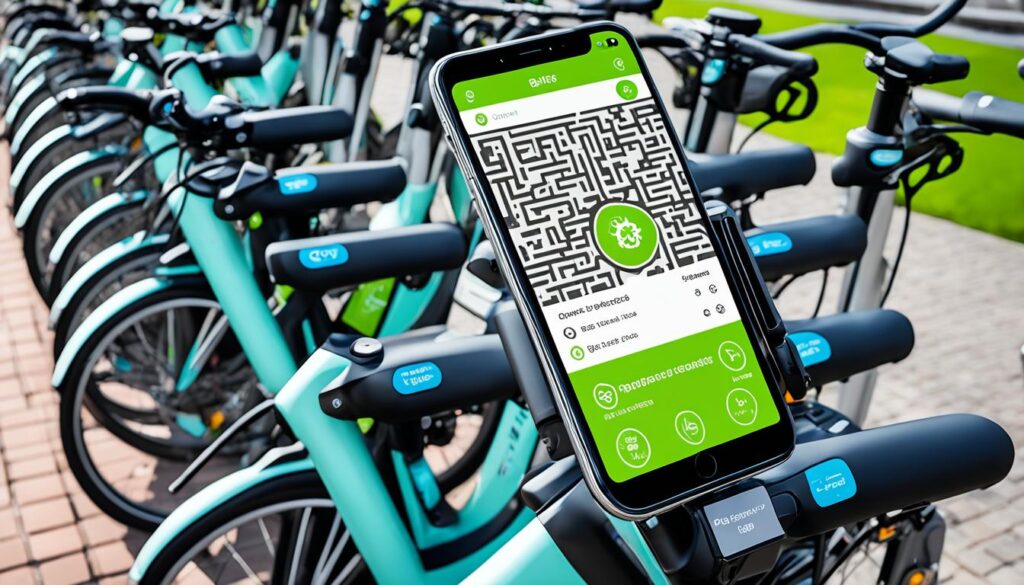Did you know that the global e-bike market is expected to reach $52.36 billion by 2028? With the rising popularity of electric bicycle rentals, many entrepreneurs are looking to capitalize on this trend by starting an e-bike business. Whether you’re interested in launching an e-bike rental startup, an e-bike sharing service, or an e-bike tour company, now is the perfect time to enter this growing industry.
Starting an e-bike rental franchise can be a lucrative venture, especially in tourist destinations or cities with busy streets that make walking difficult. To launch a successful e-bike rental business, it’s important to research your target audience, assess local regulations and permits, and choose the right e-bikes for your fleet. You’ll also need to develop a solid business plan, secure funding, find an ideal location, and establish rental policies and procedures.
Effective e-bike rental marketing strategies, such as building a strong online presence, partnering with local tourism operators, and leveraging social media and customer reviews, can help attract customers to your business. Additionally, consulting with a lawyer to draft rental agreements and obtaining liability insurance coverage are essential steps to protect your e-bike rental operations.
Key Takeaways
- The global e-bike market is expected to reach $52.36 billion by 2028
- E-bike rental businesses can thrive in tourist destinations and cities with busy streets
- Research your target audience and assess local regulations before launching your business
- Develop a solid business plan, secure funding, and find an ideal location for your e-bike rental startup
- Implement effective marketing strategies and protect your business with legal agreements and insurance coverage
Understanding the E-Bike Rental Market Opportunity
The e-bike market has experienced significant growth in recent years, with electric bicycles becoming an increasingly popular mode of transportation in cities across the globe. This surge in e-bike rental demand presents a lucrative opportunity for entrepreneurs looking to tap into the thriving electric bike tourism industry.
The Growing Popularity of E-Bikes
E-bikes have taken the world by storm, revolutionizing the way people navigate urban landscapes. The affordability of high-quality e-bikes, ranging from $1,500 to $8,000, makes starting an e-bike rental business an attractive venture. With an initial investment as low as $15,000 for a fleet of 10 bikes, the barriers to entry are significantly lower compared to other rental businesses like car rentals.
The average rental fee for an e-bike in the United States is around $10 per hour, allowing entrepreneurs to recoup their initial investment in just 150 rental hours. Depending on rental demand and service hours, it’s possible to see a profit within a little over 30 days of operating an e-bike rental company.
Identifying Your Target Audience
To capitalize on the growing e-bike rental market, it’s crucial to identify your target audience. The typical customer demographics for e-bike rentals include tourists between the ages of 16 and 75. This age group is drawn to the convenience and excitement of exploring cities on electric bikes, making them an ideal target market for e-bike rentals.
When selecting a location for your e-bike rental business, consider larger cities with multiple attractions spread out over a wide area. Tourists often prefer riding an e-bike to walking long distances, making these destinations prime spots for e-bike rental demand.
To attract your target audience, develop a marketing strategy that highlights the benefits of electric bike tourism, such as:
- Eco-friendly transportation
- Effortless navigation of city streets and bike lanes
- Ability to cover more ground and see more sights in less time
- Fun and engaging way to explore a new city
Researching your competition’s rates and offerings is essential to setting competitive prices and creating special deals that appeal to your target market. Promote your e-bike rental company through an official website and online directories like Google and Yelp to enhance visibility and accessibility for potential customers.
By understanding the growing e-bike rental market and identifying your target audience, you can position your business to capitalize on the increasing demand for electric bike tourism and establish a thriving e-bike rental venture.
Developing Your E-Bike Rental Business Plan
To set your e-bike rental business up for success, you’ll need a solid business plan. This plan will serve as a roadmap, guiding your decision-making and helping you secure funding from investors or lenders. As you craft your e-bike rental business plan, consider the following key elements:
Defining Your Business Model
Your e-bike rental business model will determine how you generate revenue and serve your customers. Will you focus solely on e-bike rentals, or expand your offerings to include guided tours and e-bike sales? Consider your target market and local competition when defining your business model. A clear, well-defined model will help you optimize your operations and maximize profitability.
Choosing Your Business Structure
Selecting the right business structure is crucial for protecting your personal assets and minimizing your tax liability. Common options for e-bike rental businesses include sole proprietorships, partnerships, and limited liability companies (LLCs). Consult with a business attorney or accountant to determine which structure best suits your needs and goals.
Projecting Your Startup Costs and Revenue Potential
To secure funding and ensure the viability of your e-bike rental business, you’ll need to project your startup costs and revenue potential. High-quality e-bikes typically cost between $1,500 and $8,000 each, so a fleet of 10 bikes could require an initial investment of around $15,000. Other startup costs may include:
- Business licenses and permits
- Liability insurance
- Incorporation fees
- Website development
- Marketing and advertising
On the revenue side, e-bike rental businesses in the United States often charge around $10 per hour. At this rate, you can expect to break even on each e-bike after approximately 150 rental hours. With a well-managed fleet and strong demand, you could potentially turn a profit within just over a month of launching your business.
By carefully projecting your e-bike rental startup costs and revenue potential, you can create a realistic financial plan that will help you secure the funding you need to get your business off the ground. As you launch and grow your e-bike rental business, be sure to monitor your actual costs and revenue closely, adjusting your projections as needed to maintain profitability and long-term success.
Securing Funding for Your E-Bike Rental Startup
With a well-crafted business plan in hand, the next crucial step is to secure financing for your e-bike rental startup. Compared to other rental ventures like car rentals, an e-bike rental business can be launched with a relatively modest investment. However, you’ll still need to raise capital to cover essential expenses such as purchasing e-bikes, acquiring licenses and permits, and other startup costs.
When exploring e-bike rental business funding options, consider the following avenues:
- Personal savings: Investing your own funds can demonstrate your commitment to the venture and help avoid interest payments on loans.
- Small business loans: Approach banks or credit unions that offer startup loans tailored to small businesses. Be prepared to present your business plan and financial projections.
- Crowdfunding: Platforms like Kickstarter or Indiegogo allow you to pitch your e-bike rental business idea to a wide audience and raise funds from interested backers.
- Friends, family, and angel investors: Reach out to your network for potential investments in your e-bike rental startup. Angel investors may offer larger sums in exchange for equity in your company.

When seeking e-bike rental investment, it’s essential to have a clear understanding of your financial needs and to communicate your business’s potential for growth and profitability. Be transparent about the risks involved and have a solid plan for allocating the funds you raise.
As you explore financing options for your e-bike rental startup, keep in mind that securing funding is an ongoing process. You may need to pursue multiple sources of capital or adjust your strategy as your business grows and evolves. With persistence and a compelling business plan, you can attract the e-bike rental business funding needed to bring your vision to life.
Choosing the Right E-Bikes for Your Rental Fleet
When starting an e-bike rental business, one of the most crucial decisions you’ll make is selecting the best e-bikes for your fleet. The e-bike models you choose will directly impact your customers’ experience and, ultimately, the success of your venture. To ensure you make informed choices, consider factors such as durability, ease of use, battery life, and overall customer appeal when evaluating e-bike brands and models.
Evaluating E-Bike Brands and Models
Some popular e-bike brands for rental businesses include Pedego, Rad Power Bikes, and specialized e-bike manufacturers. These companies offer a range of models designed to withstand the rigors of frequent use and provide an enjoyable riding experience for customers. When assessing e-bike models for rentals, look for features such as:
- Sturdy frames and components that can handle daily wear and tear
- User-friendly controls and intuitive operation
- Long-lasting batteries that can support multiple rides on a single charge
- Comfortable seating and ergonomic design for riders of various sizes
- Attractive aesthetics that appeal to a wide range of customers
Determining Your Fleet Size and Composition
The size and composition of your e-bike rental fleet will depend on factors such as your target market, location, and budget. When starting, it’s often wise to begin with a smaller fleet and scale up as demand grows. This approach helps minimize risk and initial investment while allowing you to gauge customer preferences and adjust your offerings accordingly.
Aim for a diverse fleet composition that caters to different riding preferences and skill levels. Consider including a mix of e-bike styles, such as:
- Cruiser-style e-bikes for leisurely rides and sightseeing
- Hybrid e-bikes for a versatile riding experience on various terrains
- Mountain e-bikes for adventurous riders and off-road trails
- Folding e-bikes for customers who value portability and convenience
By offering a range of e-bike models, you’ll be better equipped to meet the diverse needs and preferences of your target audience, ultimately leading to higher customer satisfaction and repeat business.
Finding the Ideal Location for Your E-Bike Rental Business
Selecting the perfect location for your e-bike rental business is a critical decision that can significantly impact your success. When scouting potential locations, it’s essential to consider factors such as local regulations, accessibility, and visibility to ensure your business attracts customers and operates smoothly.
Assessing Local Regulations and Permits
Before settling on an e-bike rental business location, thoroughly research the local regulations and permits required to operate legally. Some cities have specific guidelines or restrictions on where e-bikes can be ridden or parked. Familiarize yourself with these rules to avoid any potential legal issues down the road. Consult with local authorities and obtain all necessary permits to ensure your business complies with city regulations.
Considering Accessibility and Visibility
Accessibility and visibility are key factors to consider when choosing an e-bike rental shop location. Aim for areas with high foot traffic, such as:
- Tourist hotspots
- Busy streets
- Popular bike trails
Your rental store should be easy to find and accessible by public transportation or parking. Clearly visible signage and an inviting storefront can help attract potential customers. Additionally, consider partnering with local hotels, resorts, or tourist information centers to increase your e-bike rental business’s visibility and reach your target audience more effectively.
Setting Up Your E-Bike Rental Operations
To ensure a smooth and efficient e-bike rental operation, it’s crucial to establish clear policies and procedures, as well as implement a user-friendly reservation and payment system. By setting up a well-organized rental process, you can provide an excellent customer experience while minimizing potential issues and streamlining your business operations.
Establishing Rental Policies and Procedures
Developing a comprehensive rental agreement is the first step in establishing your e-bike rental policies and procedures. This agreement should outline the terms and conditions of use, including:
- Age requirements for renters
- Liability waivers to protect your business
- Damage policies and fees for lost or damaged e-bikes
- Rental rates based on local market conditions and competitors’ pricing
By clearly communicating your rental policies to customers, you can ensure that everyone understands their responsibilities and help prevent misunderstandings or disputes.

Implementing a Reservation and Payment System
To provide a seamless rental experience for your customers, implement a user-friendly reservation and payment system. This system should allow customers to easily book and pay for e-bike rentals online or in-store. Consider offering multiple payment options, such as credit cards, mobile payments, and cash, to cater to different customer preferences.
Investing in specialized e-bike rental software can greatly streamline your reservation and payment processes. These software solutions often include features like:
- Online booking and reservation management
- Inventory tracking and management
- Secure payment processing and integration with popular payment gateways
- Automated rental agreements and liability waivers
- Reporting and analytics to help you track business performance
By implementing a robust reservation and payment system, you can save time, reduce manual errors, and provide a more efficient and professional service to your customers. This, in turn, can help improve customer satisfaction, encourage repeat business, and ultimately contribute to the success of your e-bike rental business.
Maintaining and Servicing Your E-Bike Fleet
As an e-bike rental business owner, maintaining and servicing your fleet is crucial for ensuring customer safety, satisfaction, and the longevity of your e-bikes. Implementing a regular e-bike maintenance schedule is essential to keep your electric bicycles in top condition, minimize downtime, and reduce repair costs. By proactively addressing potential issues and performing routine inspections, you can maintain a positive reputation for your rental business.
To effectively manage your e-bike fleet, train your staff to perform basic maintenance tasks such as:
- Regularly inspecting tires, brakes, and electrical components
- Cleaning and lubricating the chain and gears
- Checking and adjusting tire pressure
- Testing and charging e-bike batteries
- Identifying and reporting any potential issues or malfunctions
For more complex e-bike repair services, consider partnering with a local bike shop that specializes in electric bicycle maintenance. Alternatively, you can hire a skilled technician to handle advanced repairs and servicing in-house. This approach ensures that your e-bikes receive expert attention and are quickly returned to your rental fleet, minimizing downtime.
Battery maintenance is another critical aspect of e-bike fleet management. Establish a protocol for regularly charging and storing batteries to optimize their performance and lifespan. Educate your staff on proper battery handling techniques and invest in high-quality charging equipment to prevent damage or premature deterioration.
By prioritizing e-bike maintenance and implementing a comprehensive fleet management strategy, you can ensure that your electric bicycles are always ready for rental and provide a safe, enjoyable experience for your customers. This commitment to quality and reliability will help you build a strong reputation in the e-bike rental market and attract repeat business from satisfied riders.
Marketing Your E-Bike Rental Business
Effective marketing is crucial for the success of your e-bike rental business, helping you attract customers and grow your venture. To maximize your reach and engage with potential clients, focus on implementing a multifaceted marketing strategy that encompasses online and offline channels.
Building a Strong Online Presence
In today’s digital age, having a strong online presence is essential for your e-bike rental business. Start by creating a user-friendly, mobile-responsive website that showcases your e-bike fleet, rental rates, and booking options. Optimize your site for search engines by incorporating relevant keywords like “e-bike rental” and “electric bicycle rentals” throughout your content. This will help improve your website’s visibility in search results and attract more organic traffic.
Consider partnering with popular e-bike brands like Rad Power Bikes, the largest ebike company in the US, or Really Good Ebikes, which offers a unique 50/50 Brand Ambassador Club. These partnerships can boost your credibility and provide access to high-quality e-bikes for your rental fleet. For example, Elkin E-Bikes & Stuff, an electric bike rental business in Elkin, NC, successfully purchased their fleet from Really Good Ebikes.
Partnering with Local Tourism Operators and Accommodations
Collaborating with local tourism operators and accommodations can significantly expand your customer base. Reach out to hotels, resorts, and vacation rentals in your area to explore cross-promotional opportunities. You can offer special discounts or packages for their guests, encouraging them to rent e-bikes during their stay. In return, these establishments can promote your e-bike rental services to their guests, increasing your visibility and driving more bookings.
Additionally, partner with local tour companies and tourist attractions to create unique e-bike experiences. For example, you can develop guided e-bike tours that showcase the best sights and hidden gems in your area. These partnerships not only provide added value for your customers but also help establish your business as a go-to resource for e-bike rentals and tours.
Leveraging Social Media and Customer Reviews
Social media platforms like Facebook, Instagram, and Twitter are powerful tools for engaging with potential customers and promoting your e-bike rental business. Create profiles on these platforms and regularly share eye-catching photos and videos of your e-bikes in action, showcasing the fun and excitement of exploring your area on an electric bicycle. Use relevant hashtags and engage with your followers to build a loyal community around your brand.
Encourage satisfied customers to leave reviews on popular sites like Google, Yelp, and TripAdvisor. Positive reviews and ratings can greatly influence potential customers’ decision to choose your e-bike rental business over competitors. Respond to all reviews, both positive and negative, to show that you value customer feedback and are committed to providing excellent service.
By implementing these e-bike rental marketing strategies, you can effectively promote your business, attract more customers, and establish a strong reputation in the growing e-bike rental industry.
Navigating Legal Considerations and Insurance
When starting an e-bike rental business, it’s essential to address the legal aspects and ensure you have adequate insurance coverage. Protecting your business from potential liabilities and complying with local regulations are crucial steps in setting up a successful venture.
One of the first steps is to consult with a lawyer experienced in rental agreements. They can help you draft a legally sound contract that outlines the terms and conditions of your rentals, including e-bike rental liability waivers and damage policies. A well-crafted rental agreement can minimize the risk of disputes and protect your business from potential lawsuits.
Consulting with a Lawyer to Draft Rental Agreements
When working with a lawyer to create your e-bike rental contracts, be prepared to discuss the following:
- Age restrictions for renters
- Liability waivers and release forms
- Damage policies and fees
- Rental duration and late return penalties
- Prohibited use clauses (e.g., off-road riding, multiple riders)
Legal advice and contract drafting services by a lawyer may cost a few hundred dollars, but this investment can save you from costly legal issues down the road.
Obtaining Liability Insurance Coverage
In addition to solid rental agreements, obtaining liability insurance is essential to protect your e-bike rental business from potential lawsuits or claims resulting from accidents or injuries involving your e-bikes. Research insurance providers that offer coverage specifically tailored to e-bike rental businesses, and ensure that your policy covers the unique risks associated with electric bicycles.
When selecting an insurance policy, consider the following factors:
- Coverage limits for bodily injury and property damage
- Personal injury protection for renters
- Equipment coverage for theft or damage to your e-bikes
- Business interruption coverage to protect against loss of income
- Premiums and deductibles that fit your budget
The estimated cost for liability insurance will vary depending on the policy chosen, but it’s a necessary expense to safeguard your business. Remember, investing in proper legal protection and insurance coverage can provide peace of mind and help you focus on growing your e-bike rental business.
How to Start an E-Bike Rental Business: A Step-by-Step Guide
Starting an e-bike rental business can be an exciting and rewarding venture, especially as the demand for electric bicycles continues to grow. To launch a successful e-bike rental business, begin by conducting thorough market research and identifying your target audience. Develop a comprehensive e-bike rental business plan that outlines your business model, structure, and financial projections. Secure funding for your startup through personal savings, loans, or investments.
When starting an e-bike rental business, choosing the right e-bikes for your fleet is crucial. Consider factors like durability, ease of use, and customer appeal when selecting e-bike models. Find an ideal location for your business, assessing local regulations, permits, accessibility, and visibility. Set up your rental operations by establishing clear policies, procedures, and a user-friendly reservation and payment system.
To ensure the longevity and success of your e-bike rental business, develop a maintenance and servicing plan to keep your fleet in top condition. Create a marketing strategy that includes building a strong online presence, partnering with local tourism operators, and leveraging social media and customer reviews. Navigate legal considerations by consulting with a lawyer to draft rental agreements and obtain liability insurance coverage. Finally, launch your business, monitor performance, and continuously adapt to customer feedback and market trends. By following these steps to launch an e-bike rental, you’ll be well on your way to creating a thriving and profitable venture.
FAQ
What are the key steps to starting an e-bike rental business?
How much does it cost to start an e-bike rental business?
FAQ
What are the key steps to starting an e-bike rental business?
The key steps to starting an e-bike rental business include researching the market, developing a business plan, securing funding, choosing the right e-bikes, finding an ideal location, setting up rental operations, maintaining your fleet, marketing your business, navigating legal considerations, and launching your venture.
How much does it cost to start an e-bike rental business?
The cost of starting an e-bike rental business varies depending on factors such as the size of your fleet, location, and business model. On average, a high-quality e-bike costs between
FAQ
What are the key steps to starting an e-bike rental business?
The key steps to starting an e-bike rental business include researching the market, developing a business plan, securing funding, choosing the right e-bikes, finding an ideal location, setting up rental operations, maintaining your fleet, marketing your business, navigating legal considerations, and launching your venture.
How much does it cost to start an e-bike rental business?
The cost of starting an e-bike rental business varies depending on factors such as the size of your fleet, location, and business model. On average, a high-quality e-bike costs between $1,500 and $8,000, so a fleet of 10 bikes could cost around $15,000. Additional expenses include business licenses, insurance, website development, and advertising.
Who is the target audience for an e-bike rental business?
The target audience for an e-bike rental business typically ranges from 16 to 75 years old and often includes tourists visiting a city on vacation. Larger cities with multiple attractions spread out over a wide area are ideal locations, as many people prefer riding an e-bike to walking long distances.
What are the most important factors to consider when choosing e-bikes for a rental fleet?
When selecting e-bikes for your rental fleet, consider factors such as durability, ease of use, battery life, and overall customer appeal. Popular e-bike brands for rental businesses include Pedego, Rad Power Bikes, and specialized e-bike manufacturers.
How can I market my e-bike rental business effectively?
To market your e-bike rental business effectively, focus on building a strong online presence through a user-friendly website and social media engagement. Develop partnerships with local tourism operators and accommodations to reach a wider audience, and encourage satisfied customers to leave reviews on popular sites like Google, Yelp, and TripAdvisor.
What legal considerations should I keep in mind when starting an e-bike rental business?
Key legal considerations for an e-bike rental business include consulting with a lawyer to draft legally sound rental agreements, obtaining liability insurance to protect your business from potential lawsuits or claims, and researching local regulations and permits required for operating an e-bike rental service.
How can I ensure the safety and longevity of my e-bike rental fleet?
To ensure the safety and longevity of your e-bike rental fleet, develop a maintenance schedule that includes regular inspections, battery charging, and repairs. Train your staff to perform basic maintenance tasks and consider partnering with a local e-bike repair shop or hiring a skilled technician to handle more complex servicing.
Who is the target audience for an e-bike rental business?
The target audience for an e-bike rental business typically ranges from 16 to 75 years old and often includes tourists visiting a city on vacation. Larger cities with multiple attractions spread out over a wide area are ideal locations, as many people prefer riding an e-bike to walking long distances.
What are the most important factors to consider when choosing e-bikes for a rental fleet?
When selecting e-bikes for your rental fleet, consider factors such as durability, ease of use, battery life, and overall customer appeal. Popular e-bike brands for rental businesses include Pedego, Rad Power Bikes, and specialized e-bike manufacturers.
How can I market my e-bike rental business effectively?
To market your e-bike rental business effectively, focus on building a strong online presence through a user-friendly website and social media engagement. Develop partnerships with local tourism operators and accommodations to reach a wider audience, and encourage satisfied customers to leave reviews on popular sites like Google, Yelp, and TripAdvisor.
What legal considerations should I keep in mind when starting an e-bike rental business?
Key legal considerations for an e-bike rental business include consulting with a lawyer to draft legally sound rental agreements, obtaining liability insurance to protect your business from potential lawsuits or claims, and researching local regulations and permits required for operating an e-bike rental service.
How can I ensure the safety and longevity of my e-bike rental fleet?
To ensure the safety and longevity of your e-bike rental fleet, develop a maintenance schedule that includes regular inspections, battery charging, and repairs. Train your staff to perform basic maintenance tasks and consider partnering with a local e-bike repair shop or hiring a skilled technician to handle more complex servicing.
Who is the target audience for an e-bike rental business?
What are the most important factors to consider when choosing e-bikes for a rental fleet?
How can I market my e-bike rental business effectively?
What legal considerations should I keep in mind when starting an e-bike rental business?
How can I ensure the safety and longevity of my e-bike rental fleet?
Author
-

Lucas Martinez is an accomplished entrepreneur with a passion for startups. He has launched and scaled multiple businesses, providing pragmatic advice on starting and growing a business.
View all posts



